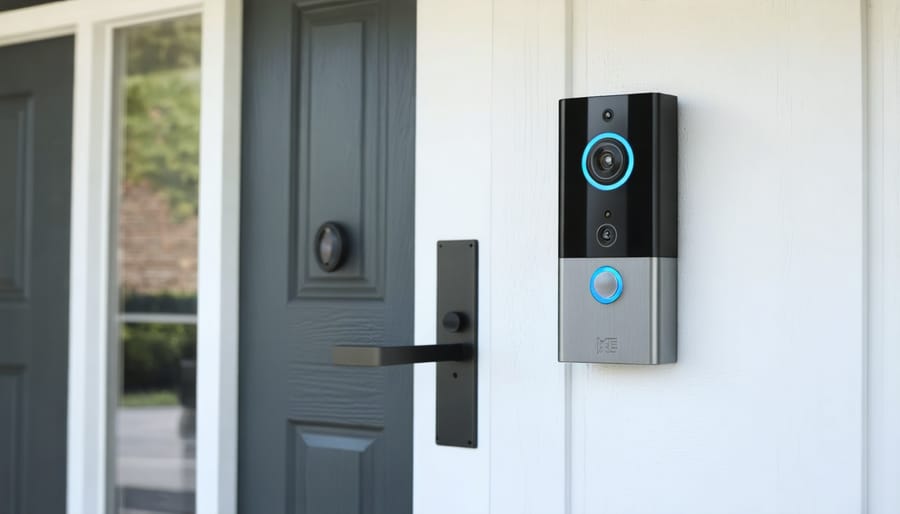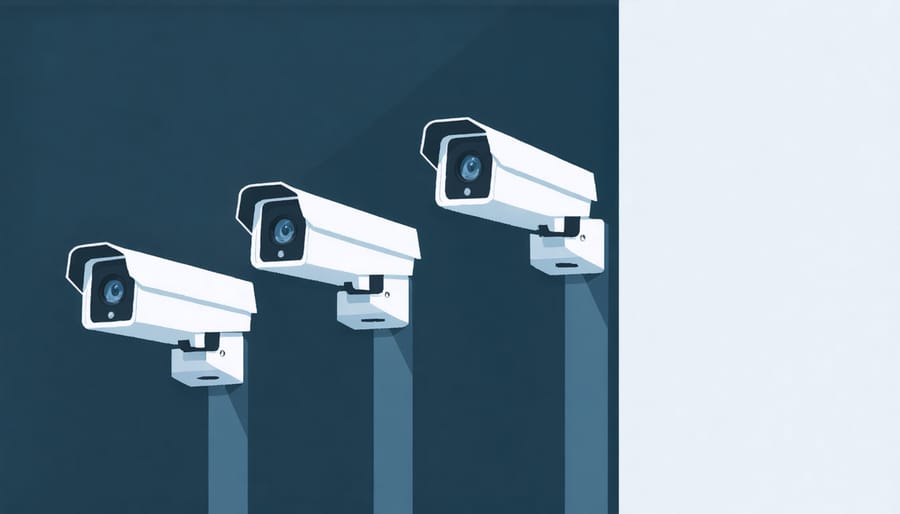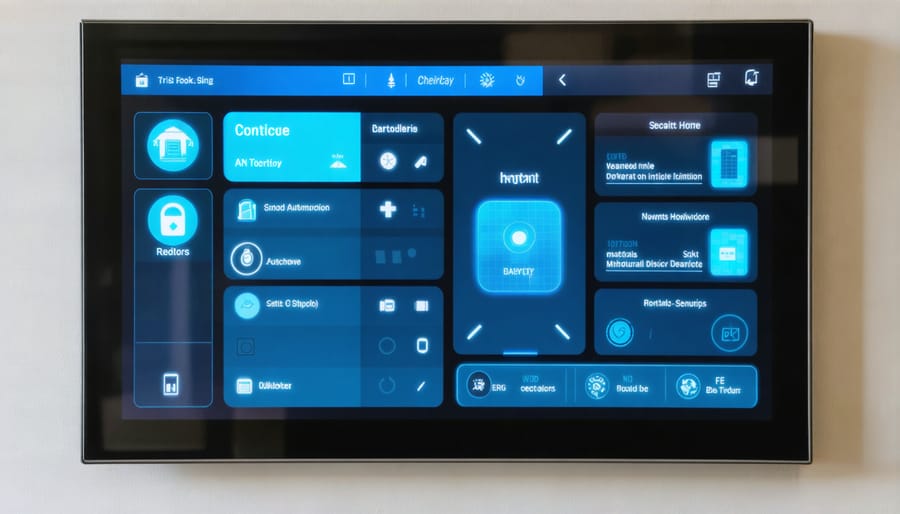Transform your home into a digital fortress by mastering essential smart home security basics. Install motion-activated cameras at key entry points, connecting them to your smartphone for real-time monitoring. Set up automated lighting schedules that mimic occupancy patterns when you’re away, deterring potential intruders. Create a secure network by regularly updating device passwords and enabling two-factor authentication on all connected home systems. Modern home security isn’t just about locks and alarms – it’s about leveraging smart technology to protect what matters most. Whether you’re a tech enthusiast or just getting started with home automation, implementing these foundational security measures will significantly enhance your home’s safety while maintaining the convenience of a connected lifestyle.
Digital Doorways: Securing Your Home’s Entry Points
Smart Doorbell Integration
Smart doorbells have revolutionized home security by giving you a virtual peephole that works anywhere you have internet access. These clever devices combine a doorbell, camera, microphone, and speaker, allowing you to see, hear, and talk to visitors even when you’re away from home.
When someone rings your doorbell, you’ll receive an instant notification on your smartphone. Whether you’re in the backyard, at work, or on vacation, you can check who’s at your door and communicate with them in real-time. This feature is particularly handy for accepting deliveries or deterring potential intruders who might be checking if anyone’s home.
Many smart doorbells also offer motion detection, night vision, and video recording capabilities. These features create a security buffer around your entryway, alerting you to any suspicious activity before someone even reaches your door. When paired with smart locks, you can remotely grant access to trusted visitors or service providers.
For the best protection, look for models with clear HD video, wide-angle viewing, and reliable Wi-Fi connectivity. Most systems store footage in the cloud, though some may require a subscription for extended video history. Consider weather resistance and battery life when choosing your device, especially if you’re installing it in an exposed area.

Window and Door Sensors
Window and door sensors are your first line of defense in creating a secure smart home environment. These small but mighty devices instantly alert you when entry points are breached, giving you peace of mind whether you’re home or away. Installing them is surprisingly straightforward – most modern sensors come with adhesive backing and connect wirelessly to your home’s security hub.
Place sensors on all ground-floor windows and doors, paying special attention to less visible entry points like basement windows and side doors. For the best coverage, install them at the top of door frames and on window sills where they’re less likely to be bumped or tampered with.
Many smart sensors now offer additional features beyond basic open/close detection. Look for models that include temperature monitoring, which can alert you to drafts from poorly sealed windows, or vibration detection that warns of attempted break-ins before entry occurs. Some advanced options even integrate with your smart home routines – automatically turning on lights when you open the front door or adjusting your thermostat when windows are opened.
Remember to check your sensors’ batteries regularly and test them monthly to ensure they’re working properly. Most smart systems will notify you when batteries are running low, but it’s good practice to stay proactive about maintenance.
Beyond the Basics: Advanced Monitoring Systems
AI-Powered Cameras
Modern AI-powered cameras are revolutionizing home security with their intelligent monitoring capabilities. These smart devices go beyond simple motion detection, offering AI-powered security features that can distinguish between people, pets, and vehicles, drastically reducing false alarms.
For optimal coverage, position cameras at key entry points: your front door, back entrance, first-floor windows, and garage. Consider installing dome cameras in corners for wider viewing angles, and ensure adequate lighting for night vision functionality. Many smart cameras now offer color night vision and built-in spotlights for enhanced visibility.
The beauty of these systems lies in their user-friendly operation. Through your smartphone, you can receive instant alerts when something unusual occurs, view live feeds, and even communicate with visitors or potential intruders through two-way audio. Some advanced models can recognize familiar faces and notify you when unknown individuals approach your property.
To maximize effectiveness, integrate your cameras with other smart devices. Connect them to your home’s lighting system to automatically illuminate areas when movement is detected, or pair them with smart doorbells for comprehensive front-door monitoring. Remember to regularly update your camera’s firmware to ensure you’re getting the latest security enhancements and protection against potential vulnerabilities.
Store your footage securely using encrypted cloud storage or local SD cards, depending on your privacy preferences and budget. Many systems offer flexible storage options with rolling footage deletion to maintain privacy while keeping important events archived.

Environmental Monitoring
Environmental monitoring is your home’s silent guardian, keeping watch over potential hazards that you can’t always see or smell. Modern smart detection systems work around the clock to protect you and your loved ones from three major threats: smoke, carbon monoxide, and water leaks.
Smart smoke detectors are a significant upgrade from traditional alarms. They not only sound an alert but also send notifications to your phone, allowing you to respond quickly even when you’re away. Many models can distinguish between slow- and fast-burning fires, reducing false alarms from cooking smoke while ensuring quick detection of serious threats.
Carbon monoxide detectors are absolutely essential, as this odorless gas can be lethal. Smart CO detectors provide real-time monitoring and instant alerts when dangerous levels are detected. Look for models that integrate with your home automation system for enhanced safety coordination.
Water leak detectors are often overlooked but can save thousands in potential damage. Place these sensors near water heaters, washing machines, dishwashers, and under sinks. The best smart water detectors can automatically shut off your main water supply when a leak is detected, preventing catastrophic flooding.
For maximum protection, consider a system that integrates all three types of monitoring. Many smart home hubs now support this kind of comprehensive environmental monitoring, giving you peace of mind through a single, user-friendly interface.

Automation for Enhanced Security
Smart Lighting Schedules
Smart lighting schedules are a game-changer when it comes to home security, creating the illusion that someone’s always home. Set up your smart bulbs to turn on and off at varying times throughout the day, especially during evening hours when burglars are most active.
Start by programming your lights to mimic your daily routine – kitchen lights in the morning, living room in the evening, and occasional bedroom lights at night. Many smart lighting systems offer “vacation mode” features that slightly vary these patterns each day, making them look more natural and less automated.
Consider motion-activated exterior lighting for your entryways, garage, and dark corners of your yard. These serve as both a deterrent and a welcome light when you return home. For extra security, link your smart lights to your home security system so they’ll flash during emergencies or automatically illuminate when motion sensors are triggered.
Pro tip: Create different lighting scenes for various scenarios – “Away,” “Night,” and “Home” modes that you can activate with a single tap or voice command. This makes it easier to maintain consistent security lighting patterns without daily management.
Emergency Response Integration
Modern smart security systems take protection to the next level through advanced emergency response integration. When an alarm triggers, these systems automatically alert local emergency services, significantly reducing response times during critical situations. Your smart home can instantly communicate essential details like your exact location, the nature of the emergency, and the fastest access points to your property.
Many systems now feature direct communication channels with monitoring centers, allowing you to speak with emergency operators through your smart devices. This two-way communication can be invaluable during emergencies, especially when you can’t reach your phone. Some advanced setups even provide first responders with temporary access codes to enter your property if needed.
To maximize this feature, ensure your system regularly updates its emergency contact list and tests its connections monthly. Consider adding medical alert capabilities if you have elderly family members or those with special needs. Remember to inform your local emergency services about your smart system to help them better prepare for potential responses to your home.
Network Security: Protecting Your Smart System
Your smart home’s network is like a digital fortress, and just like your physical doors, it needs robust protection. Start by changing default passwords on all your smart devices – yes, every single one! Create strong, unique passwords using a mix of letters, numbers, and symbols. Think of it as giving each device its own special key.
Set up a separate Wi-Fi network exclusively for your smart devices. This creates a safety buffer between your personal computers and smart home system. If one network gets compromised, the other stays protected – it’s like having a guest house separate from your main home.
Enable two-factor authentication wherever possible. This extra security step might seem like a small hassle, but it’s like adding a deadbolt to your digital door. Keep all your devices updated with the latest firmware – these updates often patch security vulnerabilities that hackers could exploit.
Consider investing in a virtual private network (VPN) for an additional layer of protection. It encrypts your smart home’s internet traffic, making it much harder for cybercriminals to intercept your data. Think of it as having tinted windows that prevent prying eyes from seeing inside.
Finally, regularly review which devices have access to your network and remove any you no longer use. An organized, well-maintained network is a secure network!
Taking steps to enhance your home’s safety doesn’t have to be overwhelming. By implementing these smart security measures gradually, you’re building a robust defense system that protects what matters most. Remember to start with the basics: securing entry points, installing smart cameras, and setting up a reliable monitoring system. Make safety a daily habit by regularly checking your devices, updating software, and maintaining emergency protocols. The peace of mind that comes from knowing your home is well-protected is invaluable. Take action today – even small security improvements can make a significant difference in keeping you and your loved ones safe. Stay vigilant, stay connected, and enjoy the confidence that comes with a smart, secure home.
